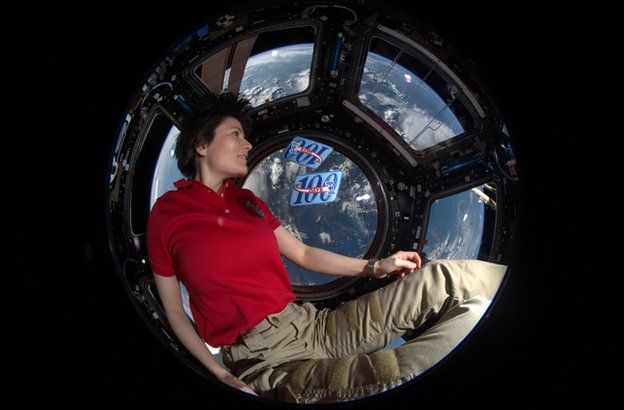Astronaut Samantha Cristoforetti on life in space
- Published

When astronaut Samantha Cristoforetti came back down to Earth earlier this month she set a new world record. The longest time spent in space by a woman on a single mission - 199 days and 16 hours on the International Space Station.
"Going into space is a great adventure but coming back is a challenge too," she says. "My body found it a lot easier to adjust to space. You have to readjust to life on the planet. You feel strange, like there is this evil giant who is trying to push you into the ground because you feel so heavy."
That was not her only issue with gravity after returning home. She also found that spending all that time floating had affected her balance and because her muscles had not been working as hard, even relatively simple tasks such as walking or sitting up straight were painful and complicated. She reckons it will be weeks before she gets back to pre-space fitness.
She did manage to do some exercise while on board the ISS as there is a mini space gym and Cristoforetti regularly used the running and weight machines to maintain her physical fitness and reduce muscle loss.
Find out more
- Samantha Cristoforetti spoke to Newsday on the BBC World Service
Some of her work in space involved carrying out scientific experiments. One of them involved using an ISS airlock for the first time and she took a sample of her exhaled breath under reduced pressure. Other research focused on genetics and other areas of biology and her expedition kept ants, worms, fruit flies and plants to study the effects of spaceflight over multiple generations.
In recent years there has been talk of sending people further into space, "A lot of the work we do on the space station is really targeted at allowing us to go to Mars one day," she says. "I'm sure the first missions will be very high risk and there is obviously a chance they will not make it back. I don't like it when people say we'll be on Mars by 2030, it depends on a lot of things and there are still definitely technological challenges we have to face."
Her working day would start with an early 07:30 meeting, linking them to international control centres in Russia, Europe, the US and Japan, to talk about the day's activities.
"I would usually get up at the last minute. I'm a night owl so would get up just in time for the planning conference and then take a little bit of time with my toilet routine and having breakfast."
Living and working on board the ISS was not as cramped as you might think. If she needed some personal space then finding a quiet area was possible.
"It's gigantic. The internal volume is like a big airliner, like a Boeing 747. If you buy an apartment or house on Earth you talk about square metres but in space you talk about cubic meters because you really inhabit the entire volume, not just the floor," she says.
And learning to move around in zero gravity did take some getting used to being "a space human being". In the beginning she spent a lot of time holding on.
"Every time you push, you're not just moving but you're turning and tumbling. As time progresses then you learn to finesse - how strong you should push, where to push off, so you can spin the way you want, or so you're not spinning at all."
It is what she will miss more than anything else. "That feeling of floating, the sensation it gives you of lightness and freedom in your body, it's an explosion of freedom and liberty. Everything is so easy."
When she wasn't working Cristoforetti was able to take some spectacular photographs of the Earth. Her favourite country to look down on was her native Italy. "It's particularly beautiful from space because of its definite shape and at night it's incredible bright, so it's quite a sight."
One of the things she missed from home was freshly brewed coffee, until an espresso machine was delivered - a huge relief after six months of instant coffee.
"It was quite a technological challenge to build a machine that could handle espresso making in space, so really well done to the team who developed it in record time."
Luckily for today's astronauts, space food has improved over the past 50 years and moved on from gloop in a toothpaste tube and freeze-dried sandwiches. The main menu the ISS crew live on is developed by Nasa's food lab.
Cristoforetti says although this means it is based on American tastes, with a lot of meat, she could complement the standard food with "bonus" items that would get delivered by unmanned spacecraft.
"I had this lovely quinoa salad with mackerel and tomatoes. I would add a little bit of olive oil and it was my favourite food. In fact I miss it - I wish I had more of those pouches down here!"